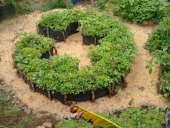
 6
6




 6
6




 1
1




Check out Redhawk's soil series: https://permies.com/wiki/redhawk-soil




 4
4





_BHL2978947_WikiMedia.org.jpg)





 2
2










"...specialization is for insects." - Lazarus Long
Universal Introduction to Permies
How Permies.com works








Miles Flansburg wrote:Yep more apples!
I would love to hear more about your Fungi in Permaculture class too Loxley.




 3
3










 1
1





_(Indian_Oyster-_Italian_Oyster-_Phoenix_Mushroom-_Lung_Oyster)_P._Kumm_by_Richard_Kneal_Wikimedia.org.jpg)




















 2
2









 1
1





"Also, just as you want men to do to you, do the same way to them" (Luke 6:31)






 2
2





"Also, just as you want men to do to you, do the same way to them" (Luke 6:31)




MizEllie and her Service Dog, MaeMae
Zone 4, NW Wisconsin
 1
1




Loxley Clovis wrote:I
IMAGE 2: Coprinus comatus, shaggy ink cap, lawyer's wig, shaggy mane, from WikiMedia.org
 2
2
















 )
) "Also, just as you want men to do to you, do the same way to them" (Luke 6:31)
 2
2




Inge Leonora-den Ouden wrote:Some of these started growing here last week ('here' is in Meppel, province Drenthe, the Netherlands). It must be some species of Lepiota, but I don't know which one.










Hester Winterbourne wrote:quote=Inge Leonora-den Ouden: ....
Well if I found that I would start by suspecting Parasol mushroom, but I would take a darn good book with me before I decided whether or not to pick and eat it. This whole thread, though fascinating, makes me slightly uneasy to think that people may see a mushroom on it and think they have spotted the same thing and eat the wrong one based on that identification. There is so much more to correctly identifiying mushrooms, and they can be so variable especially as they age that going by a photo is too risky. The stem, gills, smell, flesh colour are all also important.
And then again, it is not so easy to carry an internet based database with you into the field, which increases the risk of people picking quantities of mushrooms to take home and identify, then wasting them when they realise they are not edible after all. Give me a reliable field guide any day. But then I am a grumpy old stick-in-the-mud!
"Also, just as you want men to do to you, do the same way to them" (Luke 6:31)
 1
1




Inge Leonora-den Ouden wrote:
I agree with you Hester. I know this is some species of 'parasol mushroom', but I could not find out which species exactly. I left them at their spot (where even more are growing now!). Those parasol mushrooms are not well-known as edible mushrooms. So they probably aren't (or they don't taste well).
But the title of the topic doesn't say this is all about edible mushrooms ...





![Filename: Humongous_Fungus_armillaria-ostoyae_honey_mushroom_organism_largest-_Oregon.jpg
Description: Humongous Fungus (armillaria ostoyae) honey mushroom organism largest, Oregon [Thumbnail for Humongous_Fungus_armillaria-ostoyae_honey_mushroom_organism_largest-_Oregon.jpg]](/t/67202/a/56868/Humongous_Fungus_armillaria-ostoyae_honey_mushroom_organism_largest-_Oregon.jpg)




Hester Winterbourne wrote:...I would take a darn good book with me before I decided whether or not to pick and eat it. This whole thread, though fascinating, makes me slightly uneasy to think that people may see a mushroom on it and think they have spotted the same thing and eat the wrong one based on that identification. There is so much more to correctly identifiying mushrooms, and they can be so variable especially as they age that going by a photo is too risky. The stem, gills, smell, flesh colour are all also important.
And then again, it is not so easy to carry an internet based database with you into the field, which increases the risk of people picking quantities of mushrooms to take home and identify, then wasting them when they realise they are not edible after all. Give me a reliable field guide any day. But then I am a grumpy old stick-in-the-mud!




 . "Antioxidative activity and antidiscoloration efficacy of ergothioneine in mushroom (Flammulina velutipes) extract added to beef and fish meats". Journal of Agricultural and Food Chemistry. 56 (21): 10032–40. doi:10.1021/jf8017063. PMID 18841979.
. "Antioxidative activity and antidiscoloration efficacy of ergothioneine in mushroom (Flammulina velutipes) extract added to beef and fish meats". Journal of Agricultural and Food Chemistry. 56 (21): 10032–40. doi:10.1021/jf8017063. PMID 18841979.

_by_Lebrac-_WikiMedia.org.jpg)





![Filename: MEDICINAL-SHAMANIC-Fomitopsis_officinalis_sporophore-shaman_grave_gardian_carved_agarikon.jpg.png
Description: Fomitopsis officinalis sporophore - shaman grave gardian carved agarikon [Thumbnail for MEDICINAL-SHAMANIC-Fomitopsis_officinalis_sporophore-shaman_grave_gardian_carved_agarikon.jpg.png]](/t/67202/a/58251/MEDICINAL-SHAMANIC-Fomitopsis_officinalis_sporophore-shaman_grave_gardian_carved_agarikon.jpg.png)
 3
3










![Filename: MYCELIUM-SURFBOARD_beach_Haute-Innovation.com.jpg
Description: MYCELIUM SURFBOARD beach, Haute-Innovation.com [Thumbnail for MYCELIUM-SURFBOARD_beach_Haute-Innovation.com.jpg]](/t/67202/a/58614/MYCELIUM-SURFBOARD_beach_Haute-Innovation.com.jpg)
![Filename: MYCELIUM-SURFBOARD_fin_shroom_tip_boogie_Streamer.co.il.jpg
Description: MYCELIUM SURFBOARD fin, mushroom, tip, bodyboard, Streamer.co.il [Thumbnail for MYCELIUM-SURFBOARD_fin_shroom_tip_boogie_Streamer.co.il.jpg]](/t/67202/a/58615/MYCELIUM-SURFBOARD_fin_shroom_tip_boogie_Streamer.co.il.jpg)











Nick Kitchener wrote:I saw this the other day...
A fungi that grows in salty sand!
Psathyrella ammophila





Loxley Clovis wrote:
Folks should always be aware when eating anything -not just in the fungi kingdom- from the wild. For example, a novice forager might not know the identity & poisonous properties of hemlock (conium maculatum) or a blowfish (tetraodontidae).
 3
3





![Filename: MYCOREMEDIATION-Mushroom_eats_oil_2011.03.13-_WaldenEffect.org.jpg
Description: Mycoremediation Mushroom eats oil, WaldenEffect.org [Thumbnail for MYCOREMEDIATION-Mushroom_eats_oil_2011.03.13-_WaldenEffect.org.jpg]](/t/67202/a/59473/MYCOREMEDIATION-Mushroom_eats_oil_2011.03.13-_WaldenEffect.org.jpg)
 3
3




David Moore wrote:Constricting rings of Drechslerella snap shut. When a nematode enters a constricting ring the three ring cells (A) are triggered to swell inwards within 1 to 2 seconds and firmly lasso the victim; the cells inflate to maximum size, which is an approximate threefold increase in cell volume, within 0.1 second, with the swelling of the ring cells being strictly inward (B). The constricted rings clamp the prey firmly (C). Think, for a moment, what that description means in terms of (a) the sensory and signal transduction system that detects the presence of the nematode, (b) the reaction system that generates a burst of metabolic activity to create the osmotic potential and transport the water to inflate the cells and the localised modification of cell wall architecture that directs the morphological expansion to the interior of the loop.
Nordbring-Hertz wrote:Nematode-trapping devices. A. Scanning electron micrograph of typical adhesive network trap of Arthrobotrys oligospora, bar = 10 µm. B. Light micrograph of a nematode captured in an adhesive network trap of A. oligospora, bar = 20 µm. C. Light micrograph of conidial traps of A. oligospora, induced by the inclusion of peptides in the agar used to germinate the spores, bar = 20 µm.
Prof. Xingzhong Liu and Dr Ence Yang wrote:Natural nematode-trapping devices. A, adhesive network (an), the most widely distributed trap. B, adhesive knob (ak) with nonconstricting rings ncr. C, adhesive column (ac) is a short erect branch consisting of a few swollen cells produced on a hypha. D, constricting ring (cr), the most sophisticated trapping device, captures prey actively; when a nematode enters a constricting ring, the three ring cells are triggered to swell rapidly inwards and firmly lasso the victim within 1 to 2 second. The ring at upper left in panel D has been triggered, that at bottom right is an unsprung trap. Scale bars = 10 μm.
![Filename: NEMATODE-TRAPPER-fungal_trapping_snapping_rings_of_Dreschslerella-_by_Nordbring-Hertz-_Elsevier-_DavidMoore.org.uk.jpg
Description: Dreschslerella snap trap rings, by Nordbring-Hertz, Elsevier, DavidMoore.org.uk [Thumbnail for NEMATODE-TRAPPER-fungal_trapping_snapping_rings_of_Dreschslerella-_by_Nordbring-Hertz-_Elsevier-_DavidMoore.org.uk.jpg]](/t/67202/a/60299/NEMATODE-TRAPPER-fungal_trapping_snapping_rings_of_Dreschslerella-_by_Nordbring-Hertz-_Elsevier-_DavidMoore.org.uk.jpg)
![Filename: NEMATODE-TRAPPER-fungal_trapping_constricting_rings_of_Arthrobotrys_oligospora-_by_Nordbring-Hertz-_Elsevier-_DavidMoore.org.uk.jpg
Description: Arthrobotrys oligospora trapping constricting rings, by Nordbring-Hertz, Elsevier, DavidMoore.org.uk [Thumbnail for NEMATODE-TRAPPER-fungal_trapping_constricting_rings_of_Arthrobotrys_oligospora-_by_Nordbring-Hertz-_Elsevier-_DavidMoore.org.uk.jpg]](/t/67202/a/60300/NEMATODE-TRAPPER-fungal_trapping_constricting_rings_of_Arthrobotrys_oligospora-_by_Nordbring-Hertz-_Elsevier-_DavidMoore.org.uk.jpg)
![Filename: NEMATODE-TRAPPER-fungal_trapping_constricting_ring-_by_Prof._Xingzhong_Liu_and_Dr_Ence_Yang-_DavidMoore.org.uk.jpg
Description: Nematode trapping fungal constricting rings, by Prof. Xingzhong Liu and Dr Ence Yang, DavidMoore.org.uk [Thumbnail for NEMATODE-TRAPPER-fungal_trapping_constricting_ring-_by_Prof._Xingzhong_Liu_and_Dr_Ence_Yang-_DavidMoore.org.uk.jpg]](/t/67202/a/60301/NEMATODE-TRAPPER-fungal_trapping_constricting_ring-_by_Prof._Xingzhong_Liu_and_Dr_Ence_Yang-_DavidMoore.org.uk.jpg)

|
So I left, I came home, and I ate some pie. And then I read this tiny ad:
The new gardening playing cards kickstarter is now live!
https://www.kickstarter.com/projects/paulwheaton/garden-cards
|







